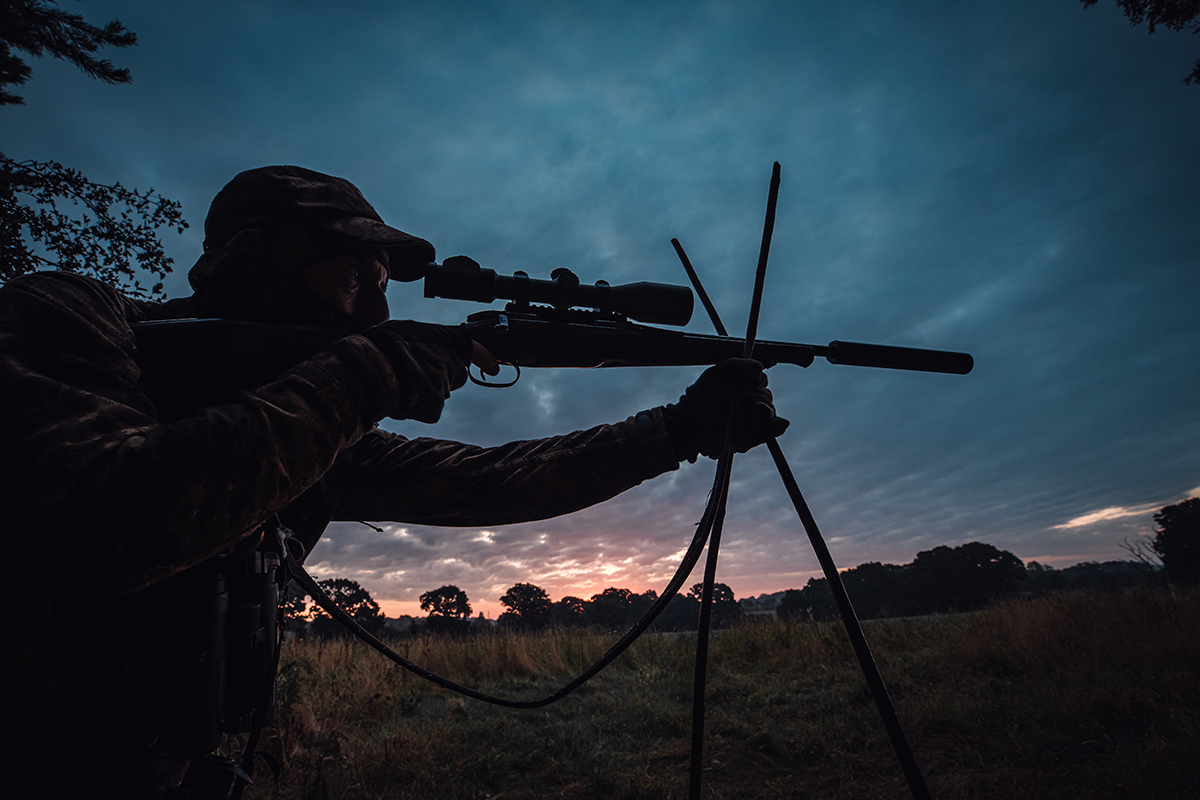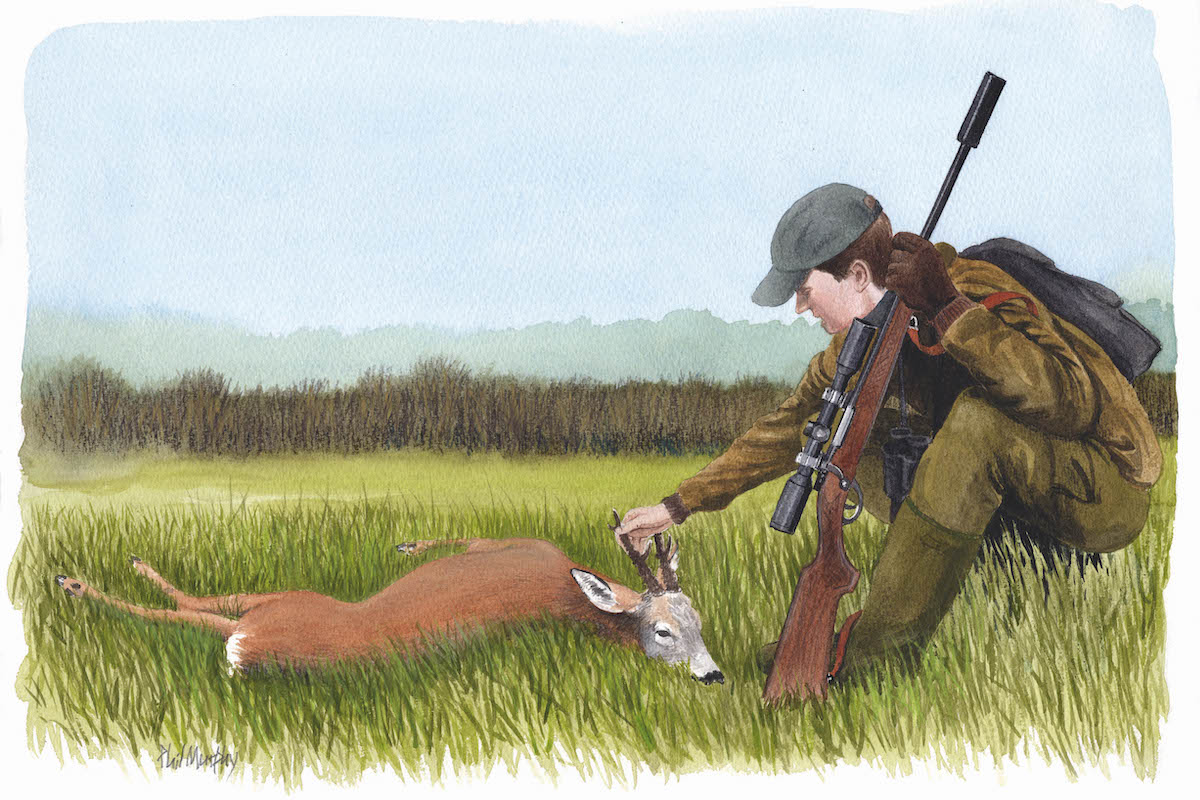Woodland stalking for roe deer
At one point, roe deer were viewed as vermin but they are now cherished quarry, says Graham Downing

It’s quiet in the woods at this time of year. Undergrowth is dense, brambles are high and roe deer are content to laze out the warmer days in the thickest of cover. But with the rides newly mown, there was a chance to make contact with a roebuck that I have spotted recently on one of the trail cams, so I set off for an early stalk.
With not the slightest breath of wind to rustle the leaves, the woods were as hushed as a cathedral as I crept along the familiar network of rides, scanning through the gloom of early dawn with my thermal binoculars, knowing that my Pulsar Krypton thermal add-on, newly delivered by the helpful folk at Scott Country, enables me to take a shot — if necessary — even in the deepest, darkest, shadiest part of the forest.
But there was no shot to be taken. The rides were quiet, apart from a Chinese water deer that stared at me out of a bramble bush. A careful scan of the arable ground and parkland alongside the main wood revealed nothing beyond an abundance of hares.
The first rays from the eastern horizon sent shafts of orange light into the wood and I concluded that the best thing, under the circumstances, would be to sit up in a high seat for half an hour and see what might turn up. Switching off the Krypton, I removed it from the front of my scope, slotted it into the pocket of my Härkila Lynx summer stalking jacket and climbed into a favourite seat.
Trail cams, thermals, scopes, high seats and custom camo clothes — it’s a far cry from the kit that the founding fathers of woodland stalking relied upon only 50 years ago. And perhaps the very youthfulness of our sport is the reason that it has proved so willing to adapt to the rush of new technology, where older, more traditional branches of shooting
have not.
Consider the game shooting field. A time traveller from Edwardian England might criticise the cut of today’s tweed breeks and look askance at the prevalence of over-and-under shotguns, but they could otherwise feel quite at home.

Trail cams are a key tool for the modern deer manager
Woodland stalking as we know it today ultimately traces its roots back to deer management practices that were implemented under wildlife legislation introduced by fanatical hunter Reichsmarschall Hermann Göring in 1930s Germany. This required all landowners to carry out regular deer counts, from which local authorities would set an annual cull plan to be undertaken by a network of well-qualified jägers, or stalkers.
Nothing remotely approaching this regime existed in Britain, where roe were regarded as little more than vermin and were killed indiscriminately on shotgun drives, from which many escaped to die a lingering death from their wounds.
Even in the mid 1950s, Richard Prior, one of the pioneers of modern stalking and a founder member of the British Deer Society (BDS), reported that 70% of the roe he shot carried shotgun pellets. Perhaps this was not so surprising. The only sportsmen who owned rifles were those who travelled regularly to stalk in Scotland and even few gamekeepers possessed a centrefire rifle beyond those responsible for managing a deer park belonging to their employer. Indeed, it was widely held that rifles were inherently unsafe to use in the countryside of lowland England.
The principles of Göring’s legislation survived World War II and a small group of British officers serving in the occupation of post-war Germany recognised the value of regulated and humane deer management, bringing the concept home with them. Among these was Major HA ‘Herbie’ Fooks, who had been in overall charge of forest and game management in the British zone of occupation, liaising between the Allied command and the German forestry and hunting authorities.

A roebuck running from a noise in another part of the wood suddenly spots Graham

A Pulsar Krypton thermal add-on makes it possible to take a shot in the shadiest areas of the wood

Thermal binoculars offer the stalker a huge advantage in woodland
Fooks studied the German system at first hand and liked what he saw. On his return, he wrote a manual —Hints on Woodland Stalking — which was published by the BDS as the first guide of its kind in the English language. Others contributed their knowledge of the German system, including Victor Ross, who had been a Jewish refugee from the Nazis, and he, like other returning soldiers and airmen, brought back to the UK the principles of selective deer control by rifle.
These found strong support among a band of enthusiasts whose primary aim was improved welfare for deer and, in 1963, this group broke away from the Mammal Society to form the BDS.
That year saw a watershed in deer management when members of the newly formed society played a leading role in providing information that would help lay the framework for the 1963 Deer Act. Coming in the wake of 1959 Scottish legislation, this at last established in England a schedule of close seasons, prohibited night shooting and the use of spears, snares, poison, traps and arrows to kill deer. This elevated the status of deer — and most especially roe deer — from that of vermin to respected quarry. Instrumental in steering the new legislation through Parliament was Marcus Kimball, MP for Gainsborough and a strong supporter of fieldsports, who went on to become chairman and then president of the British Field Sports Society.

Graham settles into a favourite high seat to see what turns up in the woods
All of these developments took place against a background of steadily increasing deer populations. Plantations originally established by the Forestry Commission in the 1920s were by now providing extensive new areas of woodland habitat in which deer were able to flourish.
Roe were increasing in both range and number, and just around the corner were more recently introduced species — sika, muntjac and Chinese water deer — all of which would bring new challenges.
Extending ranges of all deer species across lowland England brought more sporting shooters into woodland stalking and soon it was recognised that one did not need to travel to Scotland in order to stalk deer. The gun trade responded with newer and better rifles, and with equipment and accessories designed for the woodland stalker, who no longer had to rely on ex-army gear such as the ubiquitous DPM camouflage jacket.
Woodland stalking even started to appear in the pages of Shooting Times. Thumb through a copy from the 1980s and you’ll be hard pushed to find much in the way of stalking content beyond Kenneth Whitehead’s annual despatch from Scotland’s deer forests, Lea MacNally’s highland stalking articles or Richard Prior’s roe report. Nowadays, that situation has changed completely, reflecting the huge and growing popularity of the sport.
The 1997 Firearms (Amendment) Act led to a new cohort of former pistol shooters, who did not want to give up their firearms certificates, transferring allegiance to the sporting rifle. In 2007, a survey of BDS members, more than 90% of which were active stalkers, found that a third had taken up the sport within the previous 10 years, with 16% having only started stalking within the previous five. This is growth that any fieldsport should rightly be proud of in these politically correct times.

scanning for deer in the half-light of the early morning
Running roebuck
My high-seat reverie was over. Nothing had shown on the ride below me for a good half hour. The sun was rising, promising another hot, dry day. I climbed down and set off along the ride back towards where I had left the Land Rover. I had not gone more than 20 yards before I noticed a commotion at the end of the ride that my Swarovskis quickly identified as a running roebuck.
Evidently disturbed by a couple of foresters starting work in a neighbouring block of timber, it was cantering towards me down the ride. In full view, I had little option but to stand still, set up my sticks, bring the rifle to bear and wait. At a tad under 80 yards, the buck screeched to a halt, directly facing me and now more concerned about what was in front than what was behind. I had moments in which to take a frontal chest shot, but at the crucial point I squeezed the trigger he moved to turn into the wood. Instinctively, I knew it had been a miss, a fact that was confirmed by a lengthy check for blood and pins.
One has to be philosophical in such circumstances; had the buck appeared only a couple of minutes earlier, it would have presented a simple shot from the high seat.
For all our fancy equipment, woodland stalking is still a challenge. Roe deer are not easy to hunt and nor do they give themselves up readily. If they did, perhaps we would not have been pursuing them over the past 50 years with such enthusiasm and dedication.








